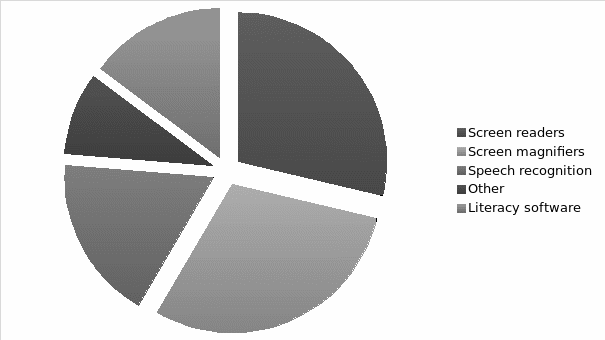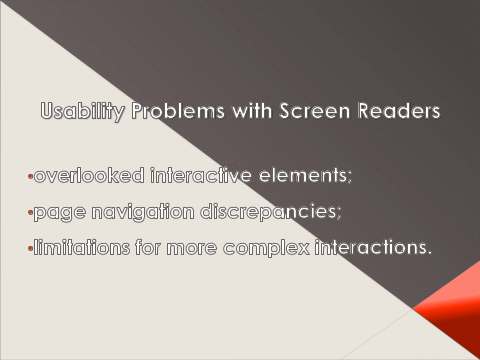Introduction
The development of digital technologies over the last decades helped a number of different categories of people gain access to information that they, previously, would not have been able to obtain. Modern technologies strive to reach disadvantaged in these aspects – assistive applications vary greatly, covering different conditions, among which is poor vision. Visual impairments pose several problems for users in tasks that may seem habitual for others. Such application software as screen readers and screen magnifiers, for instance, was designed to facilitate these tasks in educational and work environments. The most used types of assistive applications for people with low vision are shown in Figure 1 (Page, 2016). Accessibility is one of the critical features of contemporary technologies that manifests the fundamental individual right to access information; assistive applications in this regard help to achieve this essential characteristic. Despite the significant progress, visual accessibility remains a challenge that only begins to be addressed substantially.

Issues in the Precursory Technologies
Assistive application software has several precursors that formed the methodological basis upon which the technology continues to be designed. For software that helps visually impaired users access written information, text-to-speech technologies transforming textual input into voice served in the development of screen readers applications. Artificial production of the human voice is an activity that researchers had been interested in long before the idea of assistive applications was conceived – attempts to transform a piece of text into speech was pursued from the beginning of the twentieth century (Nguyen, Nguyen, Phan, & Do, 2018). Text-to-speech synthesizing attempts prepared ground for screen readers, which were popularized for commercial use, approximately in the nineties after the human rights movement, which spurred the disability rights movement afterward.
Speech synthesizers are another precursor for assistive application software that follows similar principals as text-to-speech rendering. The first attempts of creating artificial human voice were made in the eighteenth century when the first synthesizer was designed, although its possibilities were quite limited as it had a small range of produced sounds (Nguyen et al. , 2018). The Bell Telephone Laboratory advanced speech synthesizing when Voice Operating Demonstrator (VODER) was invented (Nguyen et al., 2018). At this stage, VODER and similar devices were developed without consideration for visually impaired. Moreover, the range of sounds and speech quality was lacking and needed a significant technological leap before they would be incorporated into assistive applications.
Face Detection and Privacy
Besides accessing visual information, face recognition is another challenge that visually impaired people encounter regularly. An array of face recognition applications was designed over the last decade, signaling the interest for accessibility promotion. Nevertheless, this type of software, seemingly, is inherently defective: accuracy, issues with user-friendliness, and privacy concerns accompany the development of face recognition. It is noted that recognition systems grounded in neural networks are more accurate (Zhao, Wu, Reynolds, & Azenkot, 2018). State of the art face detection is a possible solution for the accuracy problem. The technology was incorporated into Accessibility Bot, which is an application intended to inform a visually impaired person about people located, for instance, in a classroom (Zhao et al., 2018). To be able to perform the task, Accessibility Bot uses images obtained through Facebook; a visually impaired person is supposed to scan their surroundings with their phone, and the application provides information about people present (Zhao et al., 2018). The application may be viewed as posing a threat to the privacy of people who are being scanned and lays the ground for a discussion about the ethicality of such an intrusion as opposed to the benefits that it brings.
Usability Problems with Screen Readers
Screen readers constitute a significant category within assistive applications for blind users, transforming the textual type of data into the audio output. The technology advanced substantially since the invention of the first IBM screen reader destined for the DOS operating system in the middle of eighties (Nguyen et al., 2018). Despite its limitations, the screen reader achieved an enormous goal – it commercialized the technology and pushed it closer to mass production. Nonetheless, approximately thirty years later, the software’s user experience has a number of aspects that should be refined.
Overlooked interactive elements
VoiceOver is one of the most popular screen readers designed for Apple products. The application gained many proponents; still, its accessibility and usability may leave a visually impaired user dissatisfied. One of the primary concerns is insufficient comprehensiveness when the app encounters an interactive element such as a button or a link. In some instances, VoiceOver fails to signal an interactive component or does not indicate how the element could be accessed (Zhao et al., 2018). For example, the information that a button should be tapped and how many times is omitted, preventing the user from proceeding with a web page.
Page Navigation Discrepancies
Navigation order is an essential criterion to ensure a screen reader’s usability. The sequence in which a user scans a web page is supposed to be logical and precise to warrant that the information not distorted by a discrepancy of its the order of presentation. In the case of VoiceOver, for instance, the logical order is not always preserved. When using VoiceOver gestures to proceed to the following page or the preceding one, errors may occur alternating the sequence (Smaradottir, Håland, & Martinez, 2018). Smaradottir et al. (2018) state that “without training, participants could not have been able to perform such gestures. The system response and speech feedback were, in most cases, correct, but some functionalities of the system might be improved” (p. 8). Navigation order seems like one of the most fundamental elements for accessing a web page, and the issue under consideration may be frustrating and discouraging for users.
Limitations for More Complex Interactions
Visually impaired users that need to perform more specialized tasks may encounter additional problems when utilizing assistive application software. This issue is especially pertinent to students in the domain of exact sciences. According to Da Paixão Silva, de Faria Oliveira, Freire, Mendes and Freire (2017), “the use of symbols in algebraic structures is very challenging to students in general. However, when not equipped with appropriate tools, students with visual disabilities can be at a disadvantage in relation to their peers in Mathematics classes” (p. 5). Students with a visual disability that undertake to study mathematics face additional challenges – research shows that the current state of assistive technologies does not equalize visually disabled students with the rest (Da Paixão Silva et al., 2017). Therefore, screen readers, particularly in their current state of development, do not provide a thoroughly comfortable and straightforward experience for users who do not perform specialized tasks and in the latter case, do not offer substantial facilitation.

Screen Magnifiers Usability Challenges
Screen magnifiers are another widespread accessibility technology, generating multiple applications that enlarge a section of a screen. The process has not been maximized as a visually impaired user endures some of the challenges linked to the specificities of this type of application software.
Research shows that the full-screen enlargement mode, for instance, brings some shortcomings. For example, Hallett et al. (2015) note that “as magnification increases in this mode, the amount of original content that fits on the page decreases, which results in a lack of page context and inhibits access to global information” (p. 183). The flaw complicates finding specific information on a page if a user is not interested in reading everything; it is shown that screen magnifiers, generally, cannot allow visually impaired persons to obtain higher reading speed (Hallett et al., 2015). Additionally, rereading lines and horizontal scrolling that using screen magnifiers entails may decrease text comprehension. In this way, this type of application has inherent flaws emanating from its design – the flaws call for further investigation and amelioration, as seemingly, there are no substitutes that could replace the technology at this stage.
Conclusion
Blind people or those with low sight face several disadvantages daily when using digital technologies. The types of applications and software considered in the paper are designed to improve the situation. However, despite decades of activism that prompted the technological progress for visually impaired people, a range of challenges perseveres. Usability and accessibility constitute the primary frame within which the majority of issues are located. Privacy is another challenge and an ethical problem that may decelerate the development of applications that may require the incorporation of personal visual data. Moreover, assistive technology may not be obtainable for some due to costs associated with it. Therefore, the field of assistive applications is vast and necessitates further research and financial support, as it strives to alleviate some struggles of vulnerable categories of the population. Accessibility criteria in web design is a prominent problem that should be addressed further.
References
Da Paixão Silva, L. F., de Faria Oliveira, O., Freire, E. R. C. G., Mendes, R. M., & Freire, A. P. (2017). How much effort is necessary for blind users to read web-based mathematical formulae? Proceedings of the XVI Brazilian Symposium on Human Factors in Computing Systems, 1-18.
Hallett, E. C., Arnsdorff, B., Sweet, J., Roberts, Z., Dick, W., Jewett, T., & Vu, K.-P. L. (2015). The usability of magnification methods: A comparative study between screen magnifiers and responsive web design. Lecture Notes in Computer Science, 181–189.
Nguyen, T. V, Nguyen, B. Q., Phan, K. H., & Do, H. Do. (2018). Development of Vietnamese speech synthesis system using deep neural networks. Journal of Computer Science and Cybernetic, 349–363.
Page, T. GOV.UK assistive technology survey 2016. Obtenido de Accessible Digital Documents.: Web.
Smaradottir, B. F., Håland, J. A., & Martinez, S. G.. (2018). User evaluation of the smartphone screen reader VoiceOver with visually disabled participants. Mobile Information Systems, 1–9.
Zhao, Y., Wu, S., Reynolds, L., & Azenkot, S. A face recognition application for people with visual impairments. Proceedings of the 2018 CHI Conference on Human Factors in Computing Systems, 1-14.